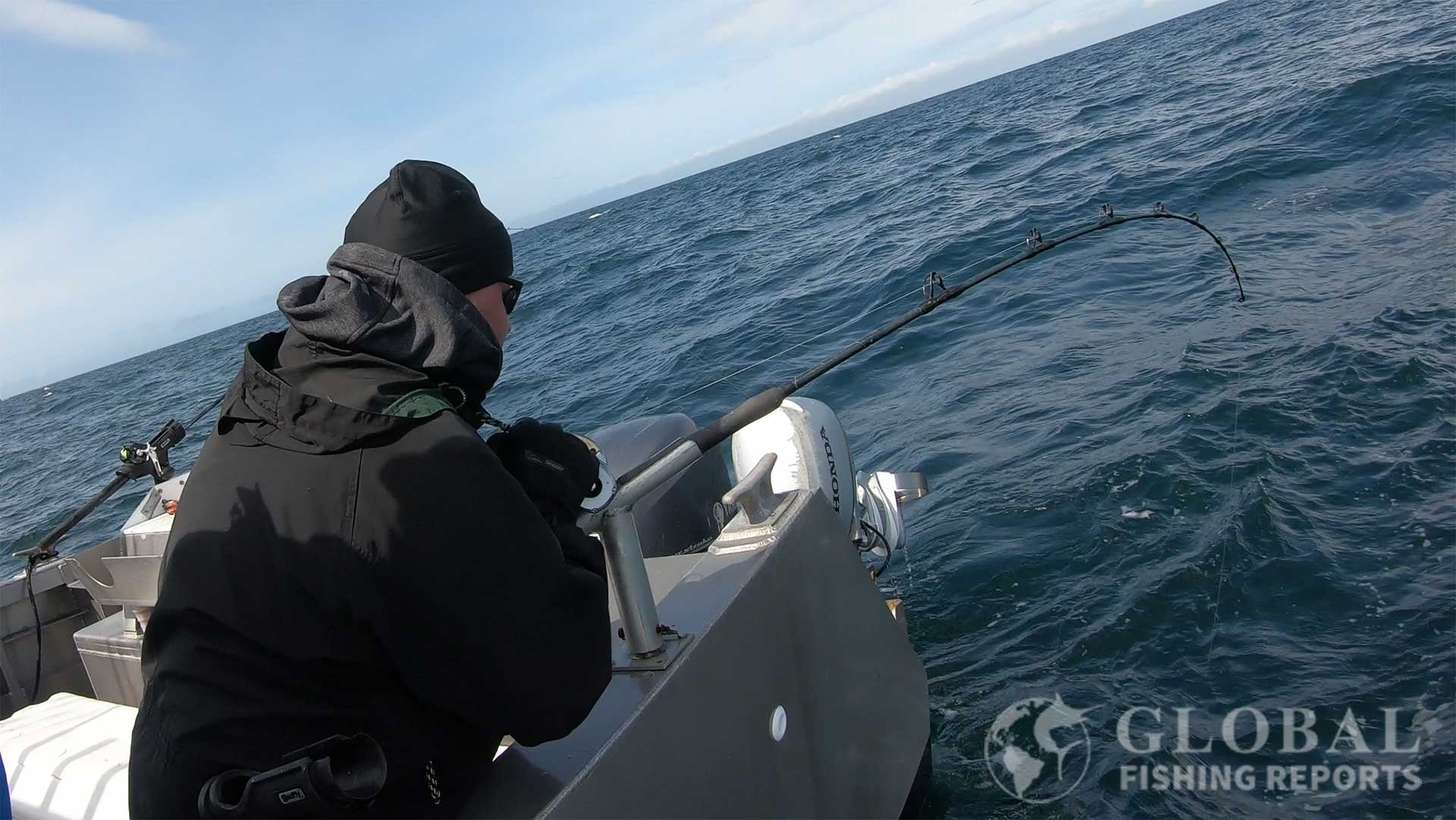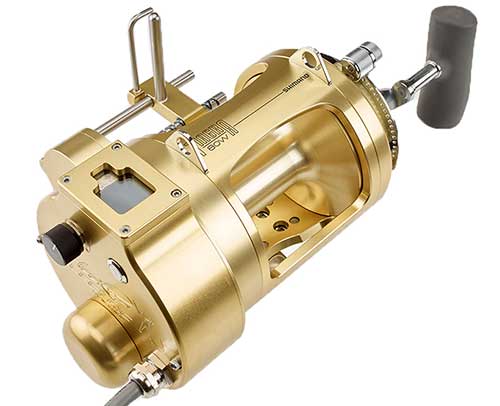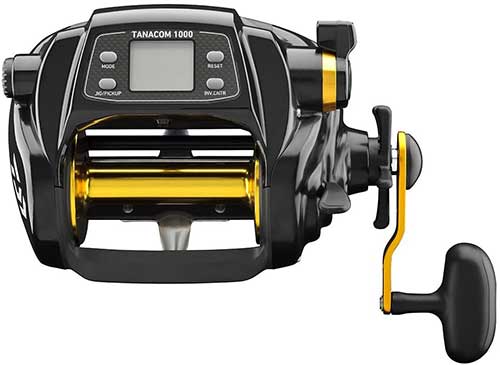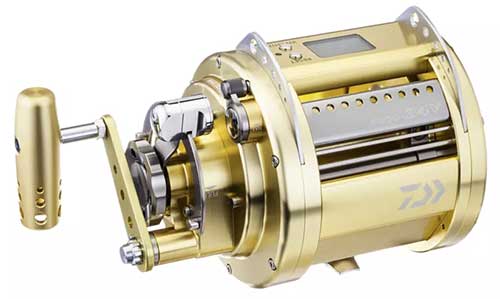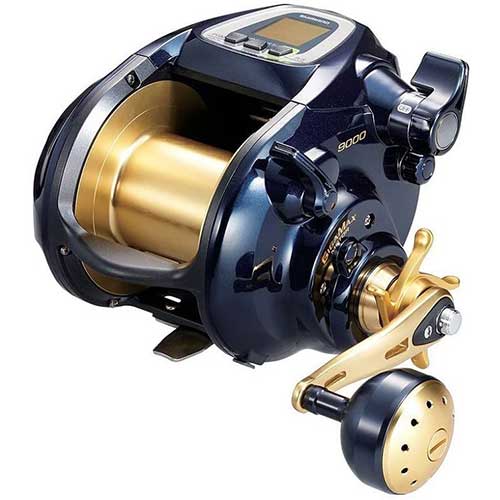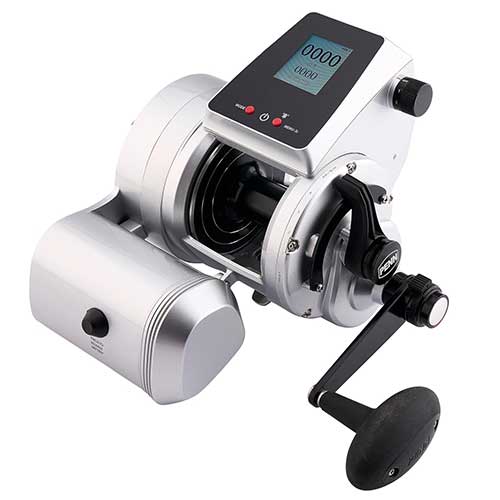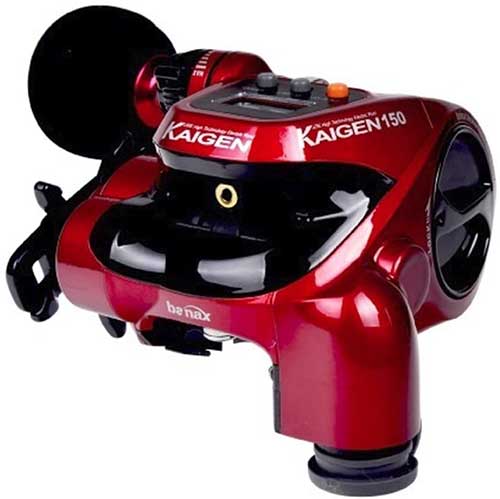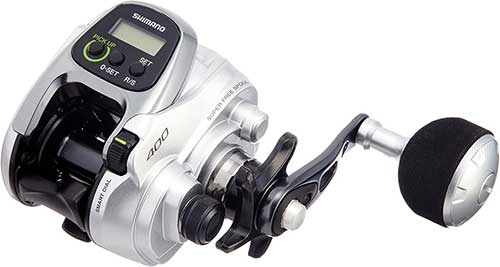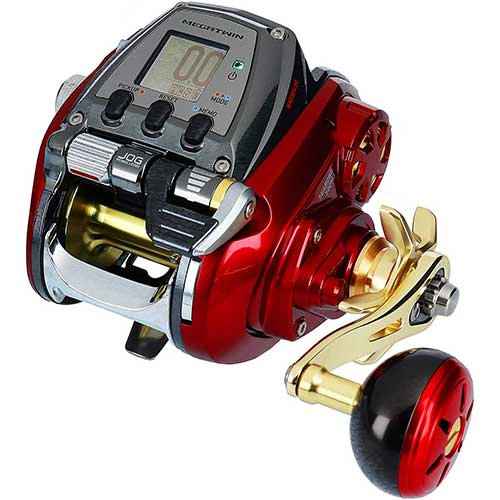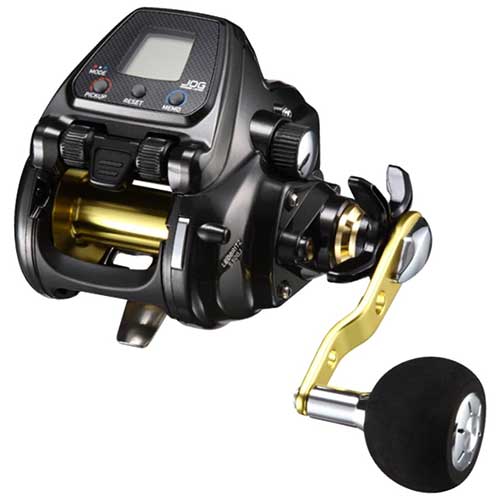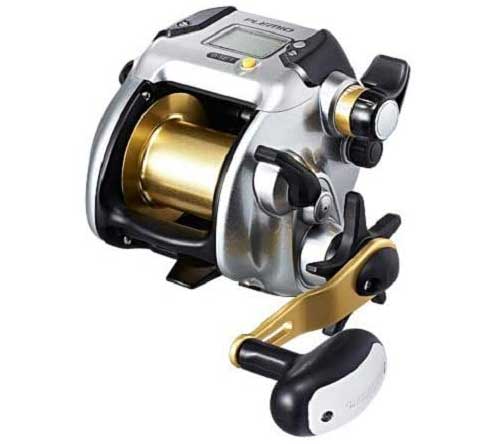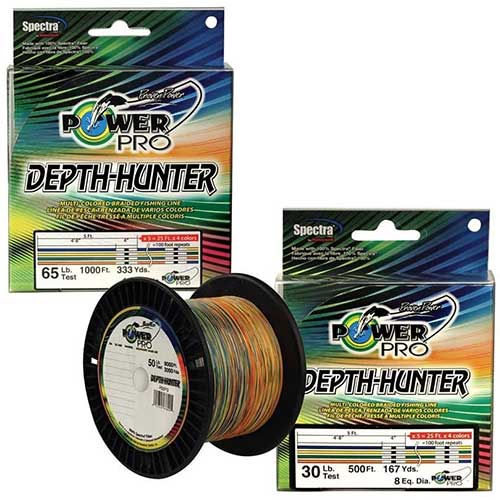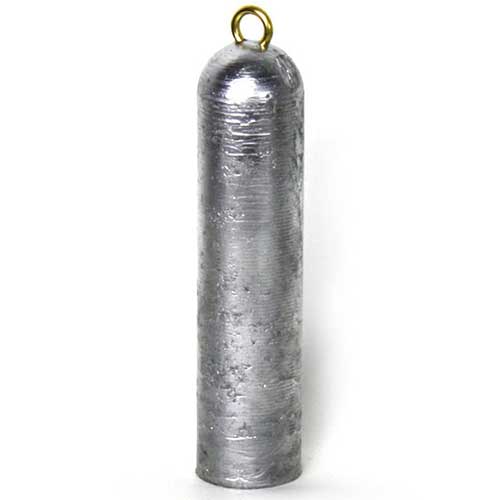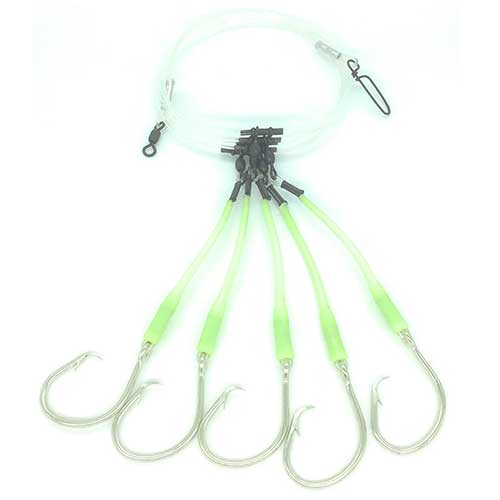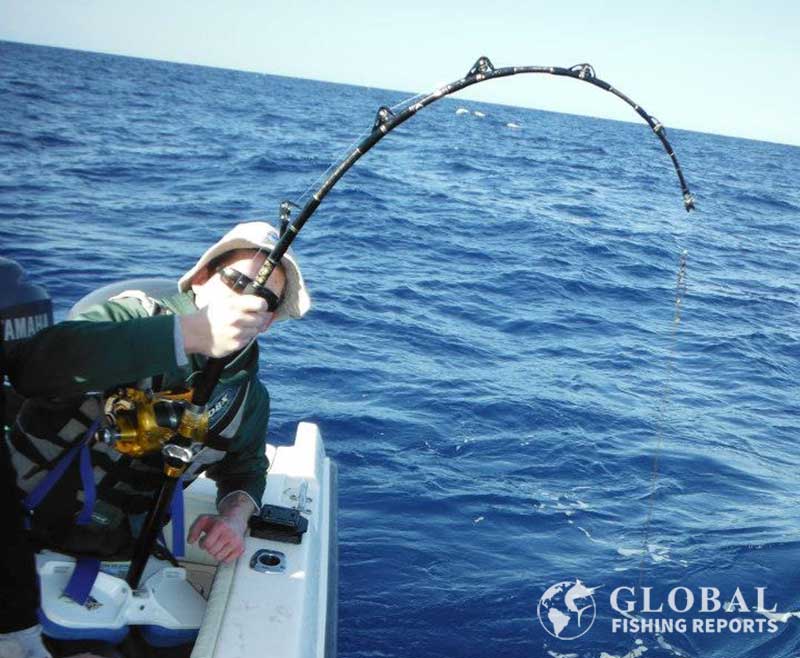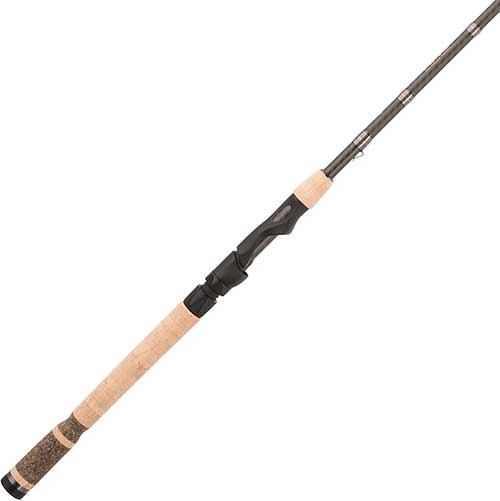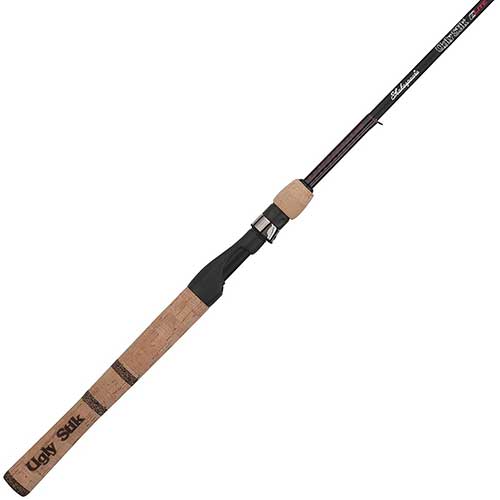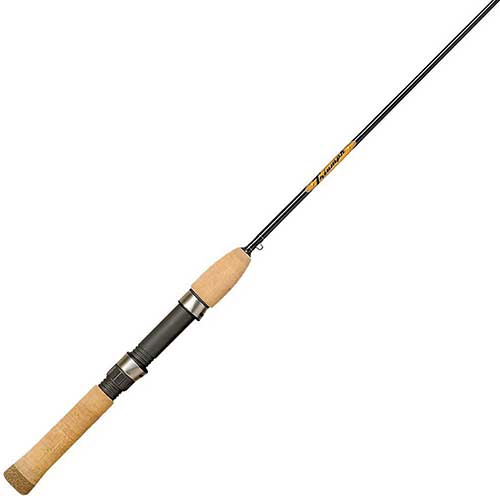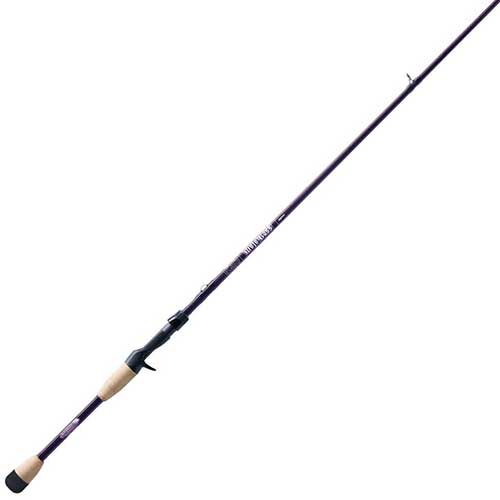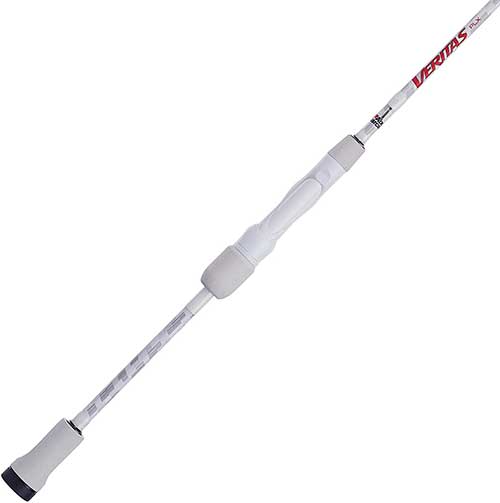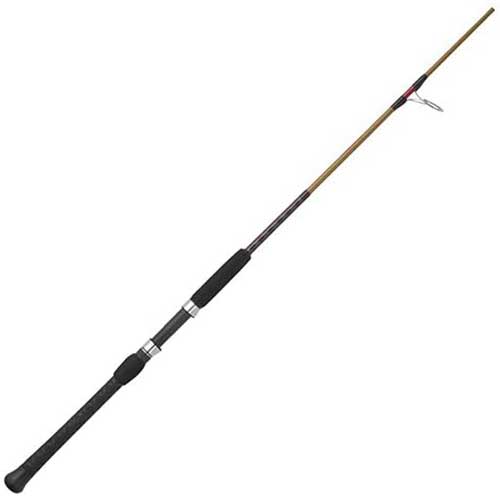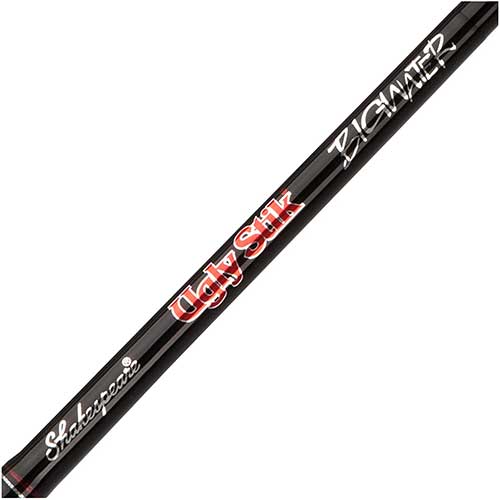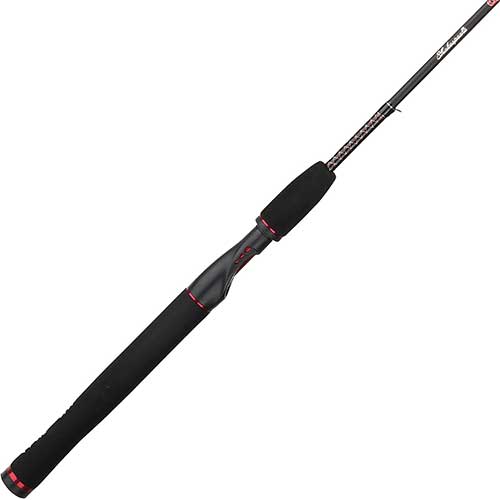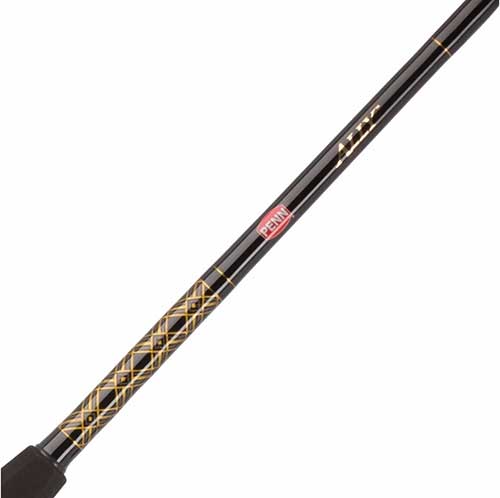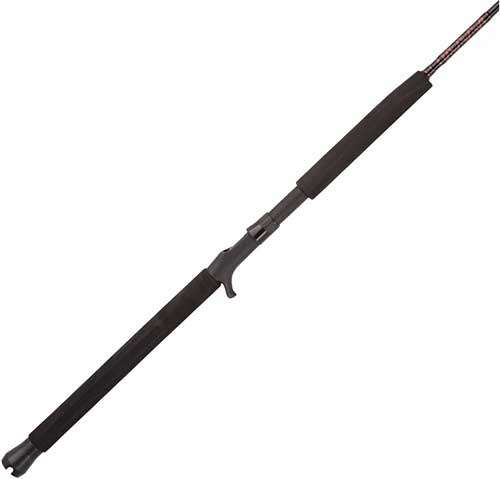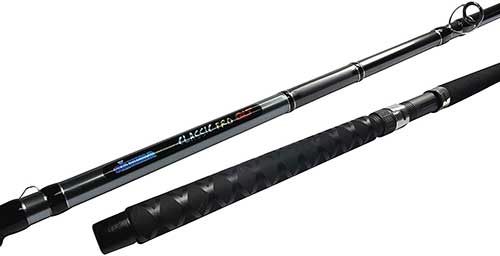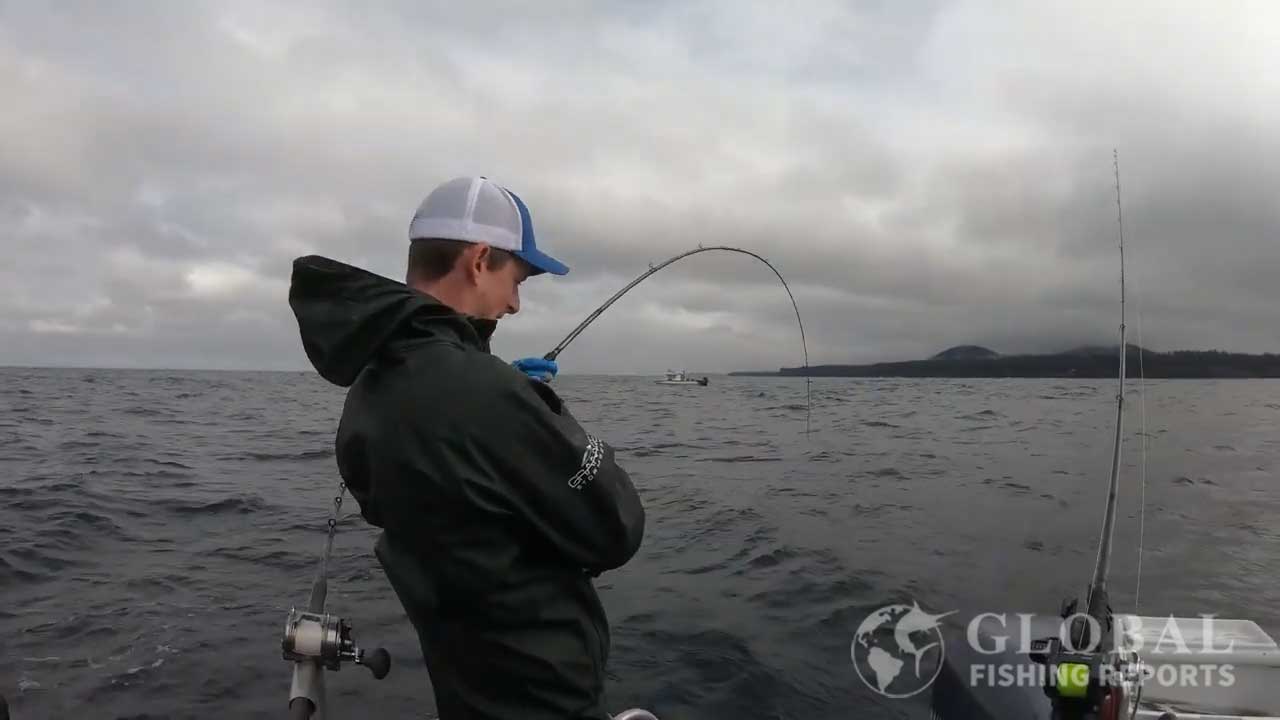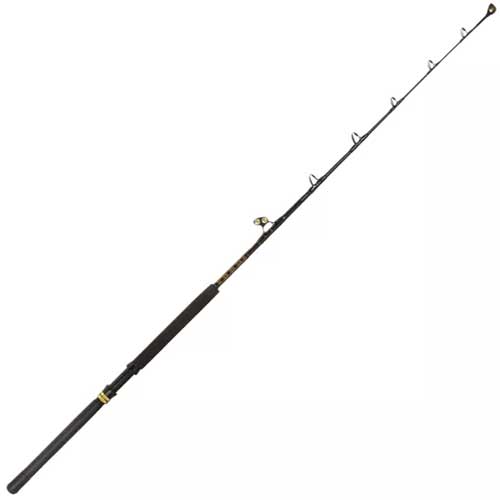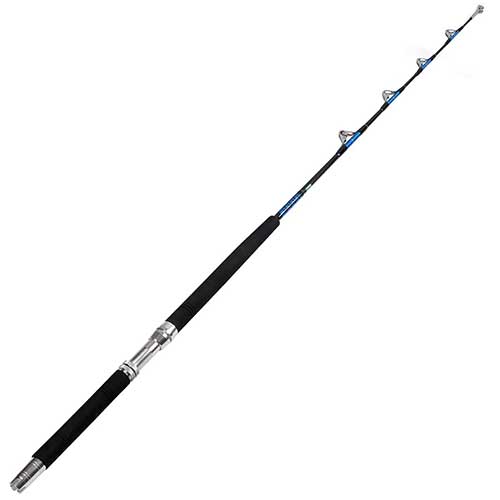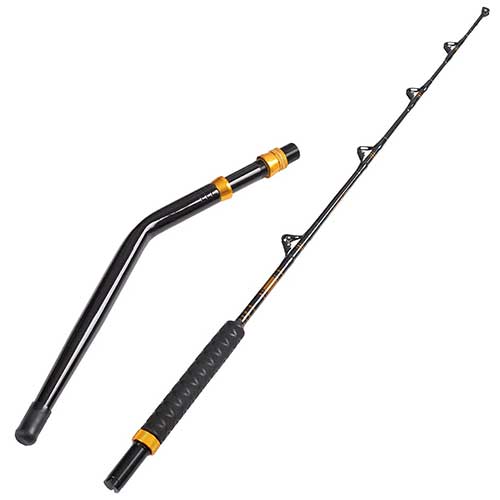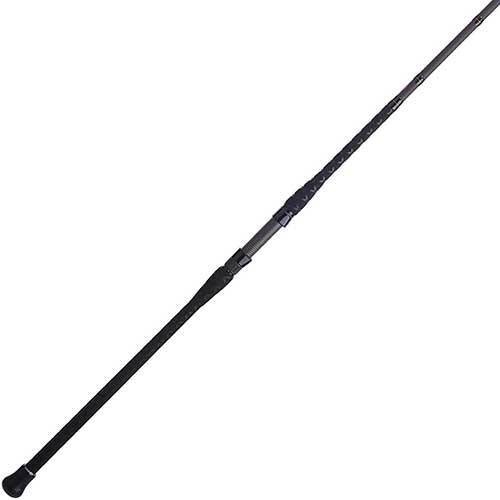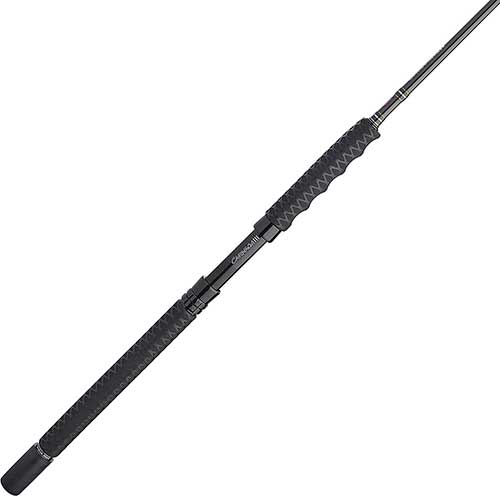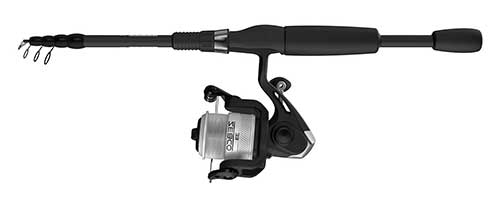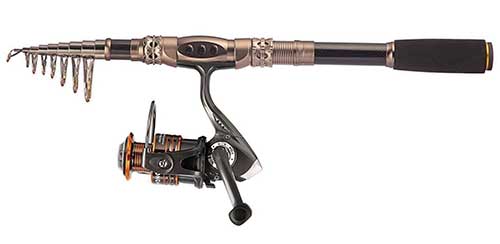Conventional trolling reels hold lots of fishing line, have strong drags, and are able to catch large fish. When I think of conventional reels, the first reel that comes to mind is a Penn International 80 which is a big game offshore fishing reel. This 80 class reel can catch the biggest fish in the ocean like bluefin tuna, marlin, swordfish, and large sharks.
There are many different styles and sizes of conventional reels and can be used to catch all types of fish. Small conventional trolling reels are used in freshwater to catch walleye, bass, musky, steelhead and salmon.
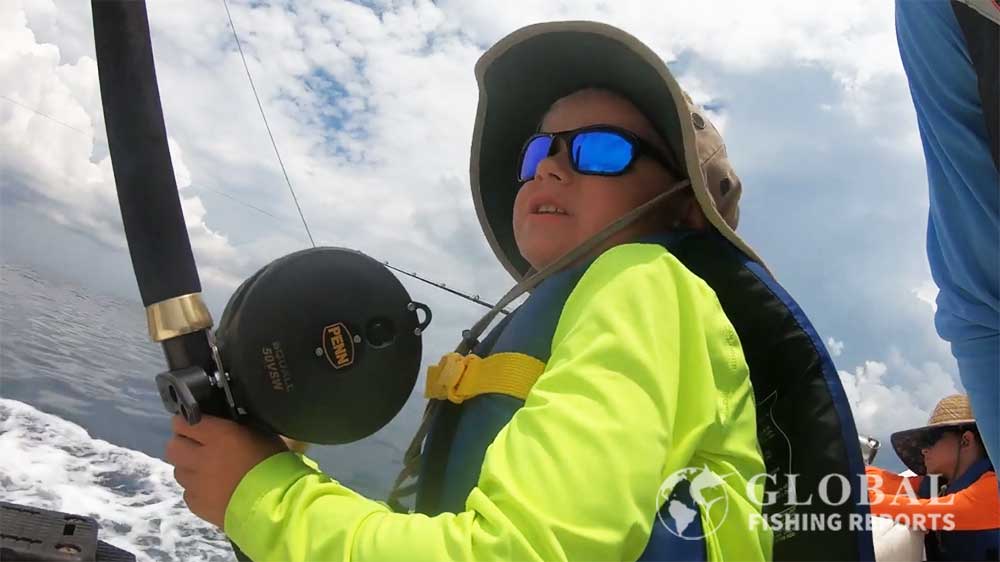
Primary Fishing Applications for Conventional Reels
Conventional reels are primarily used for two main fishing applications: trolling and jigging/bottom fishing. Let’s explore both of these applications and the reels designed for each.
Trolling Conventional Reels
Trolling involves pulling baits or lures behind a moving boat to attract fish. Trolling reels have specific features that make them ideal for this application:
- High Line Capacity: Trolling reels typically have large spools that hold substantial amounts of line. This is crucial when targeting big fish that can make long, powerful runs. The largest 80-130 class reels can hold over 1,000 yards of heavy monofilament line.
- Powerful Drag Systems: Most dedicated trolling reels feature strong drag systems that can handle the sudden strikes and fights from large fish hit while the boat is in motion. The drag needs to be smooth to prevent line breakage during the initial hit.
- Loud Clickers: Trolling reels usually have loud clicker mechanisms that alert anglers when a fish is taking line, which is essential when multiple lines are deployed.
- Harness Compatibility: Many larger trolling reels include lugs that allow a fighting harness to be attached, which helps distribute the weight of heavy fish during prolonged fights.
In my experience guiding offshore charters, 30-80 class trolling reels are great for targeting species like tuna, marlin, and wahoo. Trolling allows multiple lines to be set with lures at different depths. This makes trolling one of the most effective techniques for covering water and locating fish. For salmon trolling and freshwater trolling, much smaller conventional reels are needed, as most fish are under 50 pounds.
Big Game Reel Options
Penn International VIS 2 Speed Big Game Reel
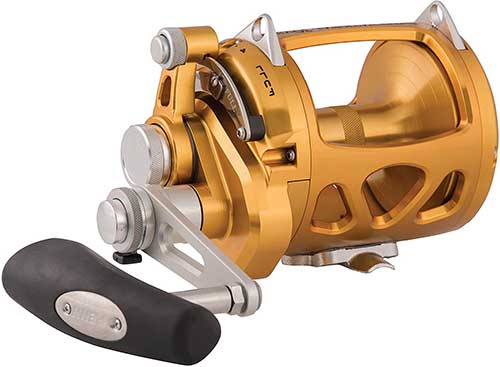
| Model 16 |
Weighs 36 oz |
| Drag 20 Pounds | Retrieves 48-14 in/turn |
| Line-capacity (yd/lb) 770/20 | L-C Braid 765/80 |
| Model 30 |
Weighs 56 oz |
| Drag 30 Pounds | Retrieves 41-14 in/turn |
| Line-capacity (yd/lb) 1030/30 | L-C Braid 1015/130 |
| Model 70 |
Weighs 74 oz |
| Drag 55Pounds | Retrieves 40-19 in/turn |
| Line-capacity (yd/lb) 960/60 | L-C Braid 2230/100 |
| Model 80 |
Weighs 113 oz |
| Drag 65Pounds | Retrieves 40-19 in/turn |
| Line-capacity (yd/lb) 1120/80 | L-C Braid 3025/130 |
| Model 130 |
Weighs 169 oz |
| Drag 100 Pounds | Retrieves 41-19 in/turn |
| Line-capacity (yd/lb) 1330/100 | L-C Braid 4175/130 |
The Penn International VI series reels come in gold or silver color options. This is the 6th generation of this classic high-quality big game fishing reel. Features of the reel include quick shift two-speed drag, dura-drag with two large-diameter drag washers, stainless steel gears, and an anodized aluminum reel body.
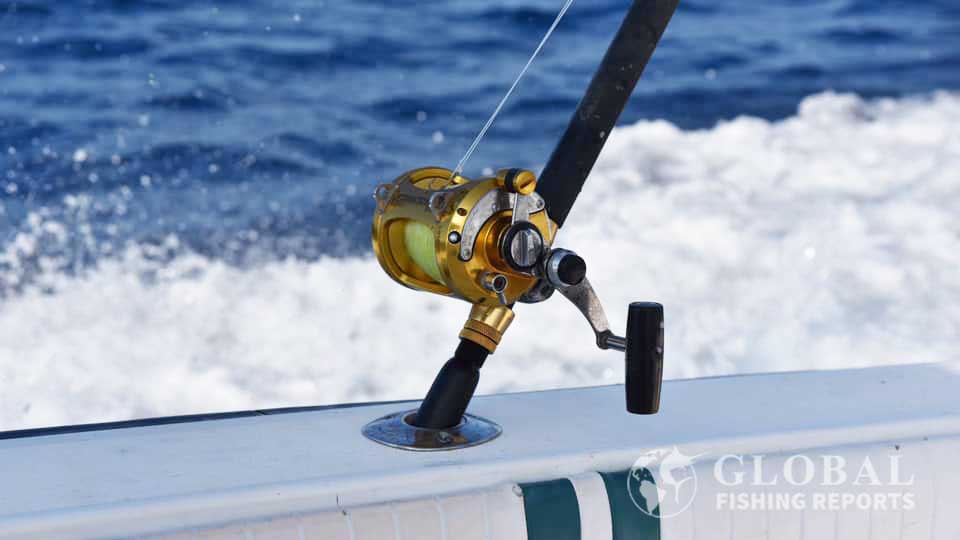
Line capacity rings mark approximately one third, two-third, and a full spool. These reels have line shedding lugs. The lugs allow a fishing harness to be hooked onto the reel. Vesa-strike allows the strike button position to be adjusted with a screwdriver. These Penn reels are made in Philadelphia USA. Below is a video that goes over all the new features of Penn International reels.

Penn Squall Two Speed Big Game Offshore Reel

| Model 16 |
Weighs 38.5 oz |
| Drag 26 Pounds | Retrieves 39-18 in/turn |
| Line-capacity (yd/lb) 540/30 | L-C Braid 1040/65 |
| Model 30 |
Weighs 47 oz |
| Drag 32 Pounds | Retrieves 41-18 in/turn |
| Line-capacity (yd/lb) 595/50 | L-C Braid 1435/80 |
| Model 50 |
Weighs 55.6 oz |
| Drag 40 Pounds | Retrieves 33-17 in/turn |
| Line-capacity (yd/lb) 890/50 | L-C Braid 1835/100 |
Note: The drag values are the max drag for the reel.
The Penn Squall 50 VSW is one of my favorite big game offshore fishing reels. This reel and the Shimano TLD 50 which is reviewed later are both awesome lightweight reels that can catch big fish. This reel even works well for high-speed trolling for wahoo. The size 50 reel weight is about the same a Penn international 30 and is half the weight of a Penn international 80. I like to always have a 50 class reel on the boat because a reel this large can catch almost any fish in the ocean.
Features of the reel include the Dura-drag system, 4 stainless steel bearings, and aluminum spool that has line capacity rings. The body of the reel is lightweight graphite and the gears are made of stainless steel. It also has a quiet double-dog anti-reverse system.

Shimano TLD Two Speed Conventional Trolling Reel
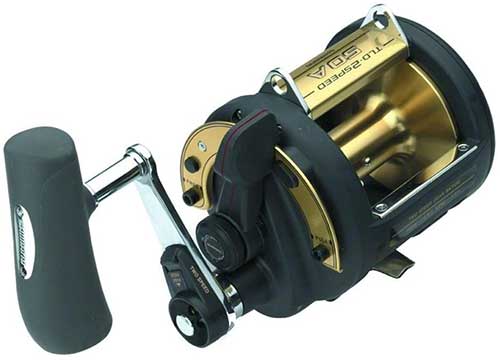
| Model 20A |
Weighs 36.2 oz |
| Drag 30 Pounds | Retrieves 137-16 in/turn |
| Line-capacity (yd/lb) 250/50 | L-C Braid 820/50 |
| Model 30A |
Weighs 37.5 oz |
| Drag 33 Pounds | Retrieves 37-18 in/turn |
| Line-capacity (yd/lb) 350/50 | L-C Braid 1210/50 |
| Model 50A |
Weighs 57.3 oz |
| Drag 37 Pounds | Retrieves 38-15 in/turn |
| Line-capacity (yd/lb) 700/50 | L-C Braid 920/100 |
| Model 50LRS |
Weighs 57.3 oz |
| Drag 42 Pounds | Retrieves 38-15 in/turn |
| Line-capacity (yd/lb) 700/50 | L-C Braid 920/100 |
The Shimano TLD-II is an offshore trolling reel that is widely used in charger fishing operations. This is because it is lightweight, durable, strong, and a great value compared to similar class reels. The TLD 50LRS can catch all types of fish from a 1 pound bonito to a 500 pound blue marlin.
This is a two-speed reel with lever drag. Features of the reel include 4+1 A-RB corrosion-resistant ball bearings, stamped graphite frame, aluminum spool, and a loud clicker. There is a football-shaped handle on the 20-30 size reels and a large offset handle on the 50 class reels. These reels will last for many years of heavy use with proper care and maintenance.
Jigging/Bottom Fishing Conventional Reels
Jigging and bottom fishing require reels with different characteristics than trolling reels:
- Lower Profile: Jigging reels are typically more compact and lightweight, as they need to be held and actively worked for extended periods.
- Faster Retrieve Rate: A higher gear ratio helps quickly retrieve jigs from deep water and maintain control of artificial lures.
- Casting Ability: Some jigging reels are designed with “free spool” features that reduce friction during the cast, allowing anglers to make accurate casts with jigs and other lures.
- Enhanced Ergonomics: Jigging/bottom fishing reels often feature more ergonomic handles and grips since they’re actively held and worked by the angler.
When I guided bottom fishing trips for halibut and rockfish in Alaska, I relied on jigging-style conventional reels that could handle the weight of heavy jigs while still being comfortable enough to use all day. The compact size and high torque were essential when working in deep water over structures.
Penn Torque Gold Lever Drag Fishing Reel
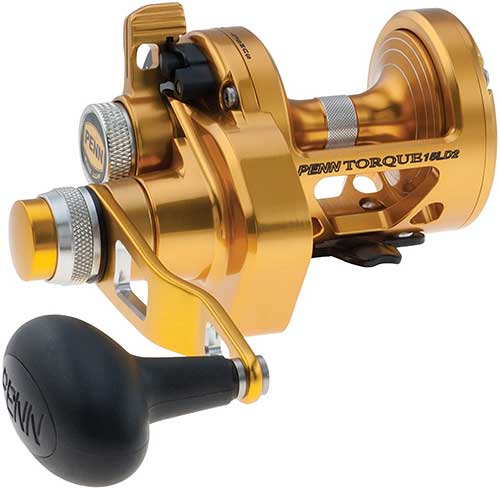
| Model 15 |
Weighs 16.7 oz |
| Drag 20 Pounds | Retrieves 30-14 in/turn |
| Line-capacity (yd/lb) 200/20 | L-C Braid 290/50 |
| Model 25N |
Weighs 21.1 oz |
| Drag 33 Pounds | Retrieves 38-19 in/turn |
| Line-capacity (yd/lb) 245/30 | L-C Braid 475/50 |
| Model 30 |
Weighs 21.5 oz |
| Drag 33 Pounds | Retrieves 38-19 in/turn |
| Line-capacity (yd/lb) 330/30 | L-C Braid 455/80 |
| Model 40N |
Weighs 27.4 oz |
| Drag 40 Pounds | Retrieves 42-21 in/turn |
| Line-capacity (yd/lb) 235/50 | L-C Braid 565/80 |
| Model 60 |
Weighs 28.3 oz |
| Drag 40 Pounds | Retrieves 42-21 in/turn |
| Line-capacity (yd/lb) 335/50 | L-C Braid 860/80 |
The Penn Torque LD2 is much smaller and lighter than the international series reels. However, they do not hold as much line. These reels are well-built and are great for trolling or vertical jigging.
Color options are silver or gold. Features of the reel include 6 shielded stainless steel ball bearings, anti-reverse, and Dura-drag. This reel has a lever drag system and has two reel retrieve speeds than can be adjusted with one hand using the quick shift system. The Penn Torque 25N and 40N have a narrow spool. These hold about the same amount of line though because the spool is taller than the standard width spool.

Penn Fathom Lever Drag Fishing Reel
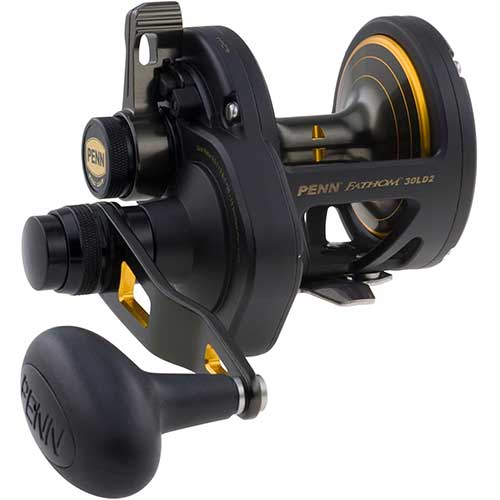
| Model 15 |
Weighs 15.6 oz |
| Drag 20 Pounds | Retrieves 31-14 in/turn |
| Line-capacity (yd/lb) 200/20 | L-C Braid 290/50 |
| Model 25N |
Weighs 19.6 oz |
| Drag 33 Pounds | Retrieves 38-19 in/turn |
| Line-capacity (yd/lb) 245/30 | L-C Braid 475/50 |
| Model 30 |
Weighs 20.0 oz |
| Drag 33 Pounds | Retrieves 38-19 in/turn |
| Line-capacity (yd/lb) 330/30 | L-C Braid 455/80 |
| Model 40N |
Weighs 25.7 oz |
| Drag 40 Pounds | Retrieves 42-21 in/turn |
| Line-capacity (yd/lb) 235/50 | L-C Braid 565/80 |
| Model 60 |
Weighs 27.3 oz |
| Drag 40 Pounds | Retrieves 42-21 in/turn |
| Line-capacity (yd/lb) 335/50 | L-C Braid 860/80 |
The Penn Fathom LD2 is very similar to the Torque LD2 above except its body and side plates are made from diecast aluminum rather than machined aluminum. This does make the reel slightly lighter.
Left-handed reels are available in the 25N and 30 size options. When using a conventional fishing reel most right-handed people hold the reel with their right hand. If you are left-handed getting a left-handed reel is likely a good idea. The narrow reels are less wide but have taller spools.

Shimano Tyronos II Conventional 2 Speed Reel
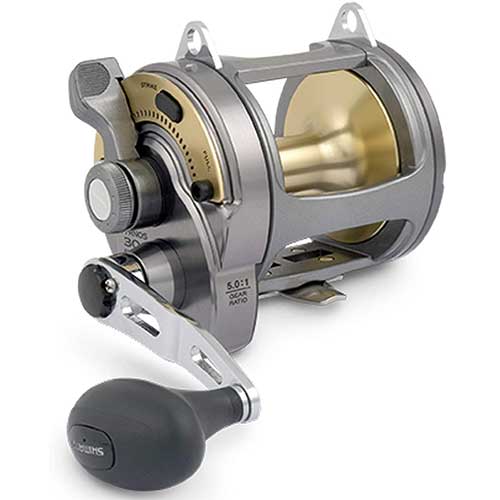
| Model 20 |
Weighs 39.2 oz |
| Drag 33 Pounds | Retrieves 45-18 in/turn |
| Line-capacity (yd/lb) 450/30 | L-C Braid 660/80 |
| Model 30 |
Weighs 40.9 oz |
| Drag 33 Pounds | Retrieves 45-18 in/turn |
| Line-capacity (yd/lb) 350/50 | L-C Braid 790/80 |
| Model 50 |
Weighs 54.7 oz |
| Drag 33 Pounds | Retrieves 44-16 in/turn |
| Line-capacity (yd/lb) 700/50 | L-C Braid 1120/80 |
The Tyrnos is a solid high-quality two-speed lever drag reel. This reel in a size 50 is what I used on charters to bottom fish for halibut and rockfish. The high gear was nice for bring up the 2-pound lead weights quickly from around 400 feet of water depth. Pushing the button in the reel handle puts the reel in low-speed for more torque when reeling in a large heavy halibut. This reel also works well when trolling inshore or offshore for small and large pelagic fish.
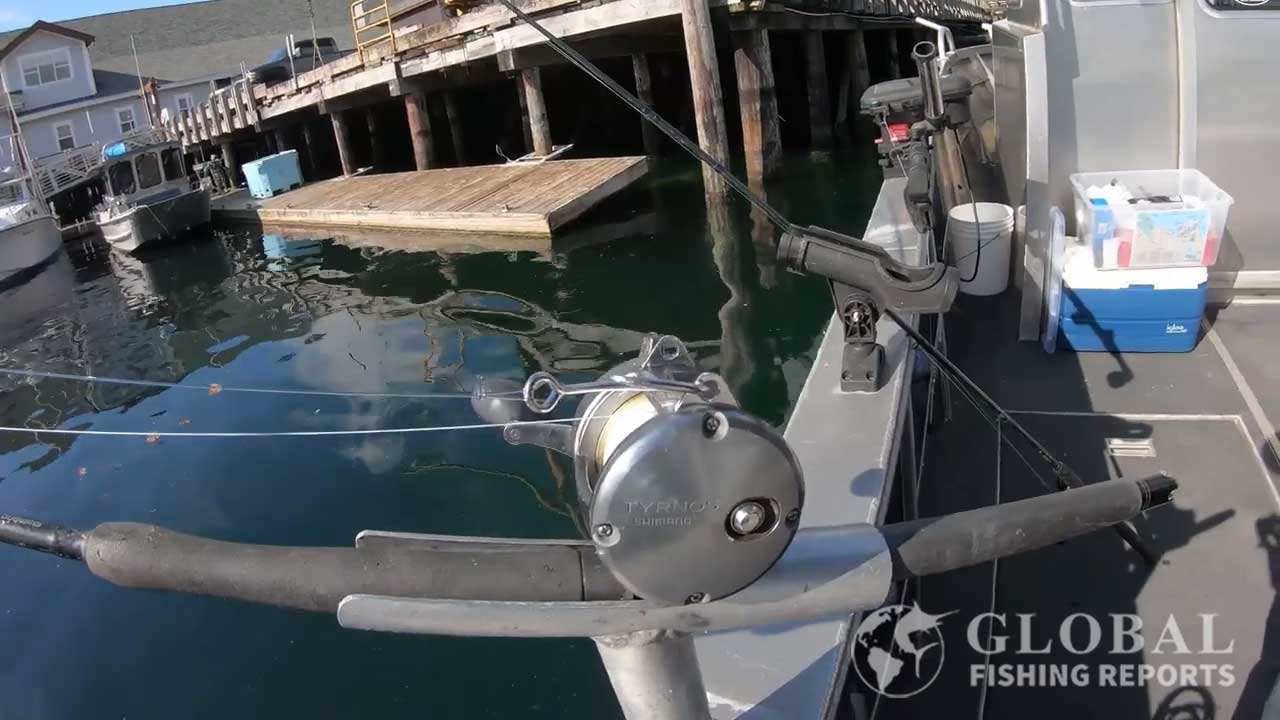
Feature of the reel includes a Hagane rigid die-cast aluminum body, 4+1 A-RB corrosion resistant ball bearings, and cross carbon drag. In the video below I show how to properly set your drag using a pull scale on both star and lever drag conventional reels.

Key Design Features of Conventional Reels
Beyond their applications, conventional reels can be categorized by several key design features:
Level-wind vs. Non-Level-wind Reels
Level-wind Reels
- Feature a mechanism that automatically distributes line evenly across the spool
- Eliminate the need to manually guide line with your thumb
- Ideal for beginners and situations where you need both hands free
- Common on smaller to mid-sized conventional reels
- Limited to lower drag settings (typically under 30 pounds)
Penn Fathom II Levelwind Trolling Reel
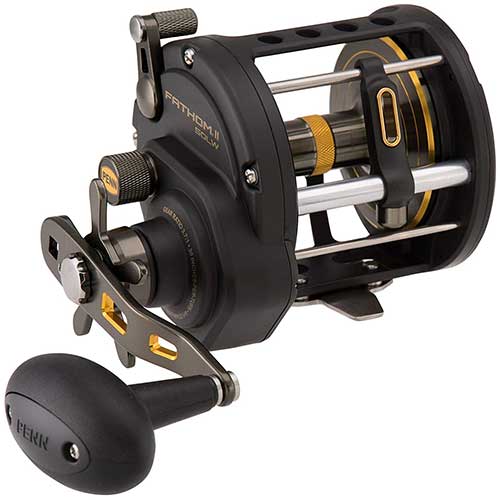
| Model 15 |
Weighs 19.8 oz |
| Drag 30 Pounds | Retrieves 30 in/turn |
| Line-capacity (yd/lb) 215/20 | L-C Braid 310/50 |
| Model 20 |
Weighs 20.9 oz |
| Drag 30 Pounds | Retrieves 30 in/turn |
| Line-capacity (yd/lb) 315/20 | L-C Braid 450/50 |
| Model 30 |
Weighs 26.1 oz |
| Drag 30 Pounds | Retrieves 31 in/turn |
| Line-capacity (yd/lb) 375/30 | L-C Braid 725/50 |
| Model 50 |
Weighs 27 oz |
| Drag 30 Pounds | Retrieves 30 in/turn |
| Line-capacity (yd/lb) 320/50 | L-C Braid 770/80 |
The Penn Fathom II is a levelwind reel. This means that line is evenly placed on the spool without having the move the line back and forth with your hand. For novice anglers this a great feature. Levelwinds can bend under high force and are not place on large high drag reels. LH stands for left-handed reel and LC stands for line counter reel.

This reel with 30 pounds of drag is still large enough to catch most types of fish including small tuna, mahi-mahi, mackerel, barracuda, striped bass, and many more. Features of the reel include a star drag system with HT-100 carbon fiber drag washers, diecast aluminum body, and 4+1 stainless steel bearing system. This Penn Fantom is a great option for a large levelwind reel. Other good large levelwind reels are the Penn Squall and Shimano Tekota 800 which will be reviewed below.

Non-Level-wind Reels
- Require the angler to manually guide line across the spool
- Fewer moving parts that could fail under heavy pressure
- Can handle much higher drag settings
- Standard on all large game fishing reels
- Better suited for targeting very large fish
I have found that level-wind reels are excellent for salmon trolling and light to medium bottom fishing. However, when targeting larger species like tuna or marlin, the level-wind mechanism becomes a liability due to the extreme pressure these fish can exert.
Penn Fathom

| Model 12 |
Weighs 16.9 oz |
| Drag 30 Pounds | Retrieves 30 in/turn |
| Line-capacity (yd/lb) 250/15 | L-C Braid 345/30 |
| Model 15 |
Weighs 17.1 oz |
| Drag 30 Pounds | Retrieves 30 in/turn |
| Line-capacity (yd/lb) 200/20 | L-C Braid 290/50 |
| Model 25N |
Weighs 19.4 oz |
| Drag 30 Pounds | Retrieves 42 in/turn |
| Line-capacity (yd/lb) 255/30 | L-C Braid 495/50 |
| Model 30 |
Weighs 20.1 oz |
| Drag 30 Pounds | Retrieves 42 in/turn |
| Line-capacity (yd/lb) 355/30 | L-C Braid 495/80 |
| Model 40 |
Weighs 20.3 oz |
| Drag 40 Pounds | Retrieves 42 in/turn |
| Line-capacity (yd/lb) 240/50 | L-C Braid 580/80 |
This Penn Fathom II is a similar version to the Fathom LD2 but has a star drag system rather than a lever drag system. This reel does not have a level-wind system. Features include a diecast aluminum body, bronze main gear, Versa drag with carbon fiber washers, and 6+1 shielded stainless steel bearings. The size 12 and 15 reels also have a magnetic casting braking system rather than the standard centrifugal braking system.
The stand out feature of this reel is the live spindle design, this allows a bait to be pitched, cast, or jigged with minimal resistance against the spool. This is possible because the design allows the spool to spin independently of the gears.
Star Drag vs. Lever Drag Systems
Star Drag Reels
- Feature a star-shaped dial adjacent to the handle
- More affordable and simpler in design
- Drag adjustment is less precise
- Typically found on entry-level and mid-range reels
- Harder to make quick, precise adjustments during the fight
Penn Squall Levelwind Conventional Trolling Reel
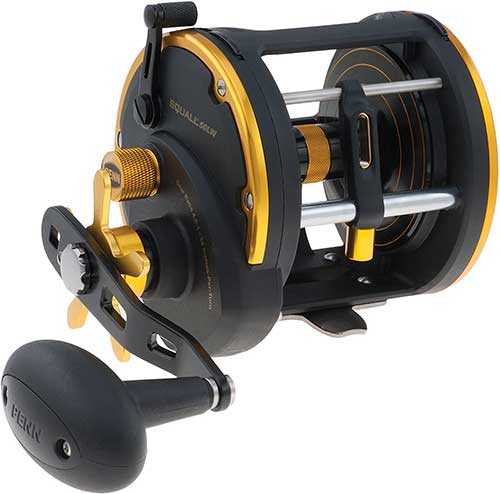
| Model 15 |
Weighs 16.2 oz |
| Drag 15 Pounds | Retrieves 28 in/turn |
| Line-capacity (yd/lb) 220/20 | L-C Braid 305/50 |
| Model 20 |
Weighs 16.9 oz |
| Drag 15 Pounds | Retrieves 28 in/turn |
| Line-capacity (yd/lb) 315/20 | L-C Braid 455/50 |
| Model 30 |
Weighs 20.9 oz |
| Drag 20 Pounds | Retrieves 35 in/turn |
| Line-capacity (yd/lb) 370/30 | L-C Braid 710/50 |
| Model 50 |
Weighs 24.6 oz |
| Drag 20 Pounds | Retrieves 32 in/turn |
| Line-capacity (yd/lb) 320/50 | L-C Braid 775/80 |
The Penn Squall is a cheaper version of the Fathom II shown above. Rather than being made from aluminum, this reels frame and side plates are made from graphite. The max drag strength is 10-15 pounds less than the Fanthom depending on the size of the reel. This is still a great conventional trolling reel and works well to catch fish under 50 pounds.
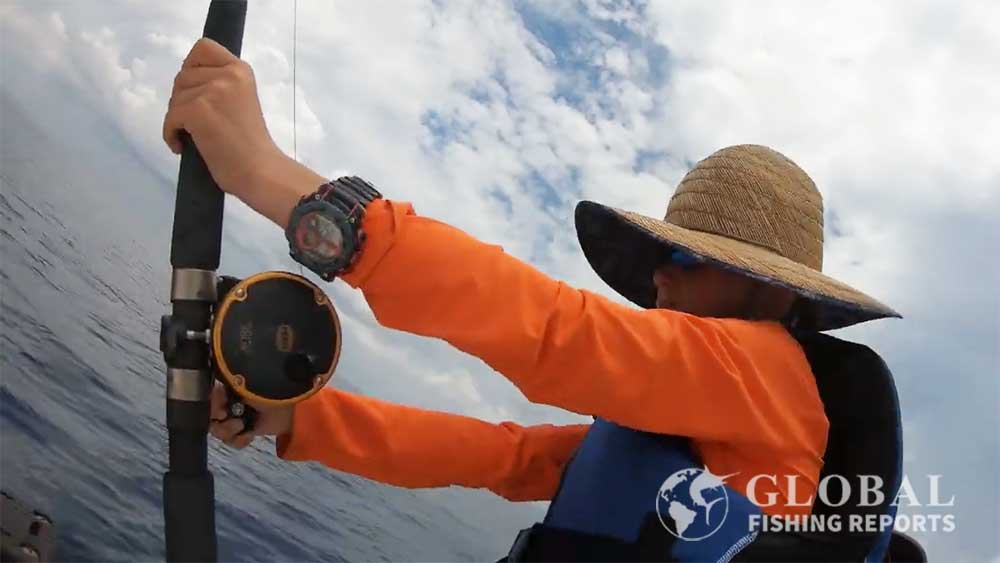
LW stands for levelwind and this reel does automatically spool the reel evenly during line retrieval. LC stands for line counter and the size 20 has a line counter option. This allows the angler to know how much fishing line has been taken off the spool. The line counter allows the depth of lure and distance behind the boat to be estimated. LH stands for a left-handed reel. Other features include a machined aluminum spool, bronze main gear, HT-100 carbon fiber drag washers, and 2+1 stainless steel bearings. The size 50 reel has switchblade lugs than come up and down to secure a fishing fighting belt if desired.

Lever Drag Reels
- Feature a lever that moves through pre-set positions
- Allow for more precise and quicker drag adjustments
- Usually include free spool, strike, and full positions
- Standard on higher-end offshore and big game reels
- Visual indication of drag setting
From my experience guiding clients, lever drag reels offer significant advantages when fighting large fish. The ability to quickly adjust from strike to full drag with a simple lever movement can be the difference between landing a trophy and losing it.
Penn Squall Lever Drag Conventional Reels
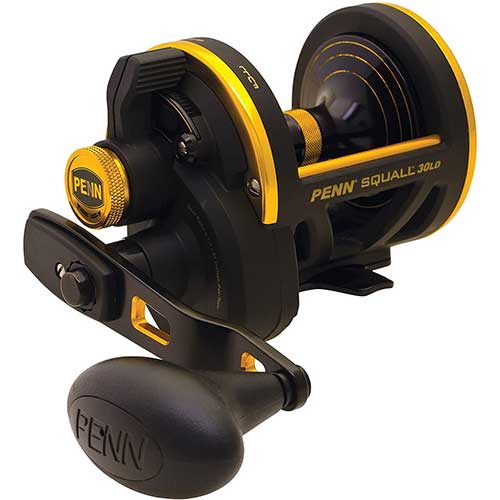
| Model DC 30 |
Weighs 18.2 oz |
| Drag 13 Pounds | Retrieves 37 in/turn |
| Line-capacity (yd/lb) 260/30 | L-C Braid 550/50 |
| Model DC 40 |
Weighs 20.9 oz |
| Drag 20 Pounds | Retrieves 37 in/turn |
| Line-capacity (yd/lb) 360/30 | L-C Braid 750/50 |
| Model DC 50 |
Weighs 27.4 oz |
| Drag 27 Pounds | Retrieves 35 in/turn |
| Line-capacity (yd/lb) 310/50 | L-C Braid 750/80 |
| Model DC 60 |
Weighs 28.1 oz |
| Drag 33 Pounds | Retrieves 33 in/turn |
| Line-capacity (yd/lb) 370/50 | L-C Braid 900/80 |
The Penn Squall LD is a lever drag conventional reel. Size 30 and 40 are topless and size 50 and 60 have a top reel frame. Features include a graphite frame, aluminum spool, Dura-drag, and 6+1 stainless steel ball bearings. On the size 50 and 60 reels, there are retractable lugs which are also called switchblade lugs.
This lever drag reel has more drag that than the star drag levelwind Penn Squall. The Penn Fathom LD2 is a very similar reel but is made of aluminum and has a higher max drag. This Penn Squall is a great reel though and works well for trolling and bottom fishing with bait or jigs.

Single-Speed vs. Two-Speed Reels
Single-Speed Reels
- Feature one gear ratio
- Lighter and more compact
- Less expensive
- Sufficient for most inshore and light offshore applications
- Simpler to operate
Two-Speed Reels
- Feature two different gear ratios that can be switched while fighting a fish
- High gear for fast retrieval of lures and line
- Low gear provides increased torque for fighting powerful fish
- Essential for deep dropping and big game fishing
- Usually activated via a button in the handle or side of the reel
The Tyrnos in a size 50 is what I used on charters to bottom fish for halibut and rockfish. The high gear was nice for bringing up the 2-pound lead weights quickly from around 400 feet of water depth. Pushing the button in the reel handle puts the reel in low-speed for more torque when reeling in a large heavy halibut.
Specialized Conventional Reel Types
Line Counter Reels
- Feature a mechanical or digital counter that displays how much line has been deployed
- Essential for precise depth control when trolling
- Popular for Great Lakes trolling and salmon fishing
- Help replicate successful presentations

I used line counter reels for a full salmon charter season in Alaska. The line counters held up all season fishing pretty much every day without any problems. My only complaint about some models is the star drag would not always hold a constant value.
Okuma Cold Water Line Counter Trolling Reel
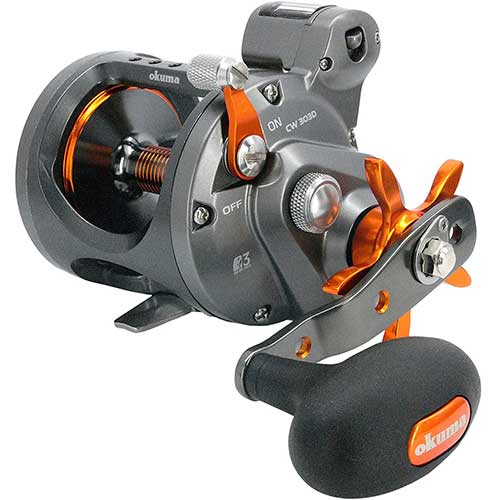
| Model 153 |
Weighs 14.6 oz |
| Drag 18 Pounds | Retrieves 23 in/turn |
| Line-capacity (yd/lb) 290/12 | L-C Braid 290/40 |
| Model 203 |
Weighs 15 oz |
| Drag 18 Pounds | Retrieves 23 in/turn |
| Line-capacity (yd/lb) 290/14 | L-C Braid 290/45 |
| Model 303 |
Weighs 20 oz |
| Drag 20 Pounds | Retrieves 24 in/turn |
| Line-capacity (yd/lb) 420/20 | L-C Braid 420/65 |
| Model 453 |
Weighs 21.8 oz |
| Drag 20 Pounds | Retrieves 26 in/turn |
| Line-capacity (yd/lb) 580/20 | L-C Braid 580/65 |
The Okuma Cold Water is a very popular line counter fishing reel. Features of the reel include 2+1 stainless steel bearings, a drop-down gearbox that lubricates the gears, ratcheting star drag, and a speed lock pinion gear system. This reel is constructed with an aluminum two-tone spool, large brass drive gear, and a graphite body. The 203 model is a ladies edition reel with pink rather than orange anodized parts.
This is a great reel for trolling for walleye, striped bass, steelhead, and salmon. The levelwind of this trolling reel does work with a lead core fishing line. There is an Okuma Cold Water Cw-553ls levelwind reel that works with wire-line. That particular reel retrieves 40.7 inches of line per turn of the handle.
Topless (Open Top) Reels
- Feature an open top design without the bridge over the spool
- Allow for direct finger control of the spool
- Improved casting performance for some techniques
- Easier to control line during drops
- Popular for jigging applications
Electric Reels
- Feature electric motors that assist in line retrieval
- Essential for very deep water fishing (800+ feet)
- Reduce physical strain during deep dropping
- Common for targeting swordfish and deep-water grouper
- Available as purpose-built units or as conversions of manual reels
Narrow Spool Reels
- Feature taller, narrower spools
- Designed specifically for use with braided lines
- Provide better line management with thin diameter lines
- Often designated with an “N” in the model number
Common Questions about Convential Fishing Reels
What is a conventional fishing reel?
Conventional fishing reels are sometimes called trolling reels, big game reels, deep-sea fishing reels, and bottom fishing reels. These reels hold lots of fishing line and are built to catch large fish. Some conventional reels have a levelwind to evenly place the line on the spool. However, with big game reels, the force on the line can bend and break the levelwind. 50 class reels, 80 class reels, and 130 class reels do not come with a levelwind, and the angler has to move the line back and forth with his hand.
Another important feature for a conventional reel is the type of drag. There is lever drag and star drag. Lever drag is typically stronger and more consistent. A newer feature on many conventional reels is a topless design. This makes it so the angler can manually adjust the force on the spool when sending out lures and jigs. This is done by pressing down on the spool with your fingers.
How do I choose a conventional reel?
When choosing a conventional reel is is important to buy the proper size reel. The two main factors when it comes to size is line capacity and max drag. Braided fishing line is much thinner than monofilament and often allows smaller lighter reels to be a good option.
The max drag should be 50 percent or more of the line strength intended to be fished with. For example, if you plan to fish with a 50-pound test line the max drag should be 25 pounds or greater. If fishing in saltwater the reel should have a sealed drag and a sealed bearing system. Having a line counter on the reel is nice when fishing with diving plugs to help estimate lure depth.
What reels are good for trolling and bottom fishing?
Topless conventional reels work well for trolling and bottom fishing. These reels often have lever drag that is strong and smooth for trolling. The open-top area allows manual resistance to be easily applied to the spool with fingers. This is nice when sending lines deep when bottom fishing or jigging.
When bottom fishing casting is not needed so a spinning reel is not the best option. Spinning reels are nice when jigging because they are lightweight. There are many small conventional reels today that can be spooled with braided line and perfect for stand up jigging.
What is the best tuna reel?
The best tuna reel depends on what size tuna is being targeted. For small skipjack, bonito, albacore, and blackfin tuna a 30 class reel is a great option. When trolling for yellowfin tuna a Penn International 50 or Shimano Tiagra 50 would be a good option. For bluefin tuna, over 400 pounds a Penn International 80 or Penn International 130 class reel is needed.
There are some heavy-duty saltwater spinning reels that can catch large tuna up to about 400 pounds. That is more for the challenge though than for practical reasons. For smaller tuna spinning reels are a good way to pitch live baits and use topwater poppers.
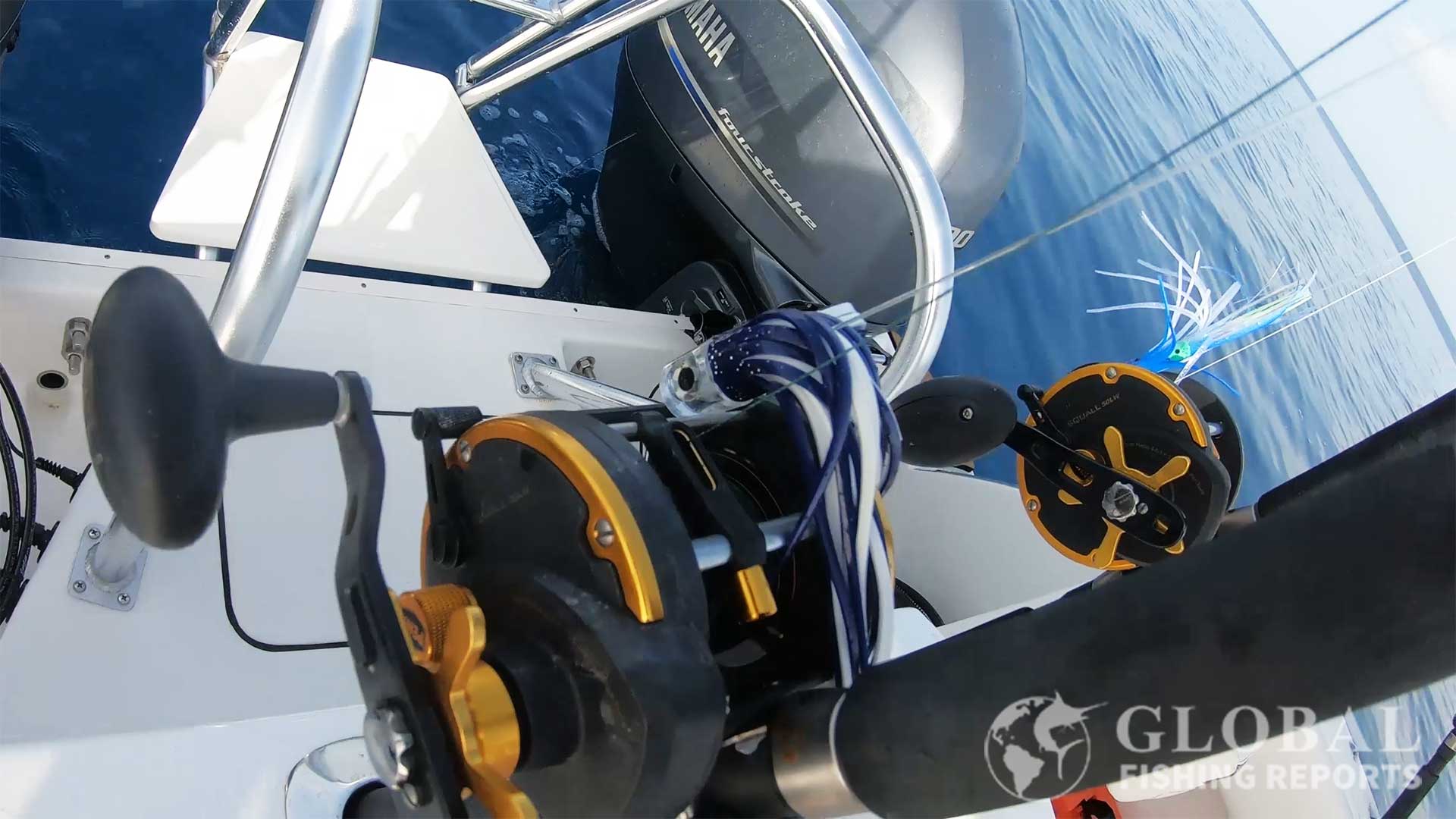
Can you troll with a braided line?
There are advantages and disadvantages to trolling with a braided fishing line. When trolling with diving lip plug lures braided fishing lines allow the lures to dive deeper into the water because there is less drag on the line itself. However, the braided line is more visible to the fish and using a monofilament or fluorocarbon leader is a good idea.
Braided line is stronger for a given thickness but is static and has very little stretch to the line. For this reason, it is important to have a reel with a quality smooth drag when trolling with a braided line. When high speed trolling for wahoo with a braided fishing line a 20-foot shock leader is added to add some flex to the system to prevent high forces from pulling the hook or breaking the line.
How do you spool a big game reel?
The most common way to spool a big game reel is to use a 60-pound monofilament line on the entire spool. This line is strong enough to catch wahoo, tuna, marlin, and mahi-mahi. Often times the leader line will be much heavier than the mainline.
When fishing for fish over 500 pounds it is common to use a 200-pound dacron line as backing to add lots of line to the spool that will stay good for several years. The reel is then topped off with a 130-pound monofilament line that is replaced once a year or as needed with heavy use. When daytime swordfishing it is common to fish deeper than 1800 feet. For swordfish reel it common to spool a large electric 80 class reel completely with braided line. The thinner diameter braid also has less drag in the current which helps keep the bait deep with less weight.
Can you use a conventional reel from shore?
Most conventional reels can only be cast a short distance and do not work well from shore. However, sometimes when fishing for large sharks, for example, a large conventional reel that holds lots of line is needed. Rather than casting the line can be set by the wind or current by using a float. Another common way to set a line from shore is by sending the out with a kayak but still fishing from shore. Some people even used drones to drop fishing lines while beach fishing. In general, though a bait runner spinning reel is the best option for shore and surf fishing.
Captain Cody has worked on charter fishing boats in the Florida Keys, Virgin Islands, and Alaska. Growing up in Pennsylvania Cody has also done extensive freshwater fishing including bass fishing tournaments. Cody strives to provide detailed information about the best fishing gear and tactics to help both novice and experienced anglers have a more productive and enjoyable time on the water. Cody also has a background in aerospace engineering and neuroscience but really only takes pride in being good at one thing and that is fishing!

